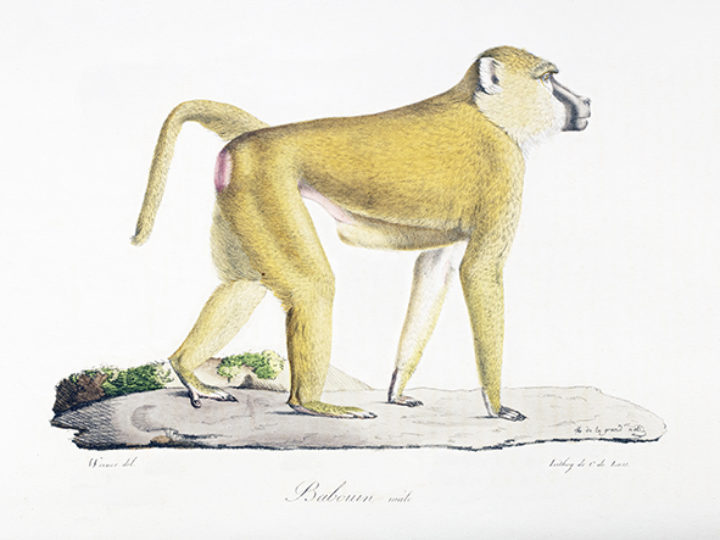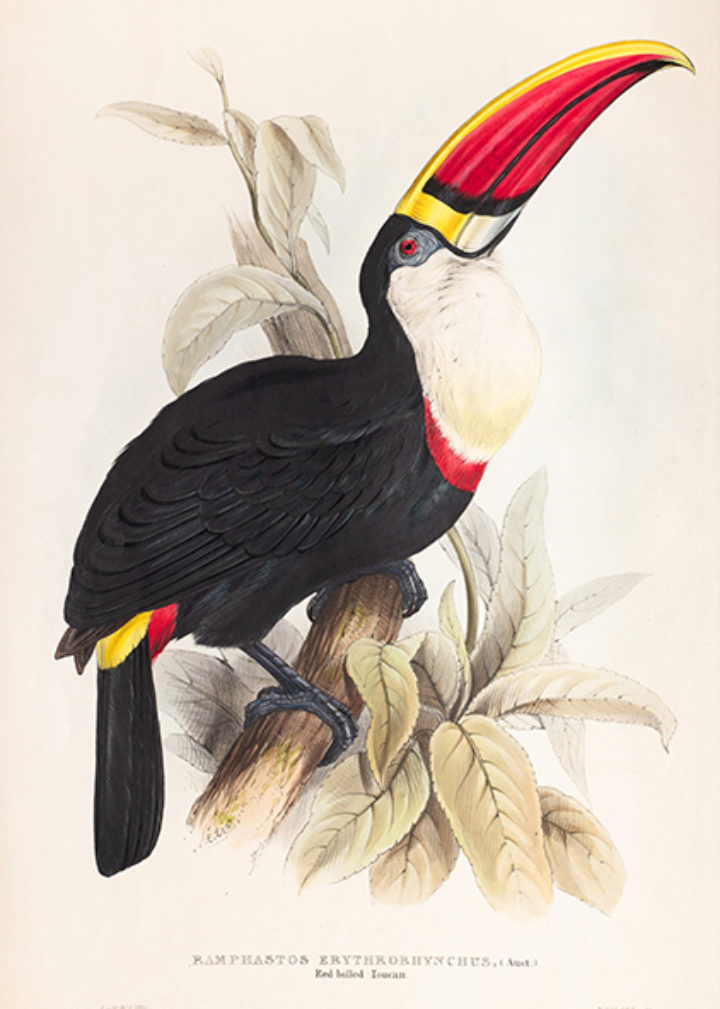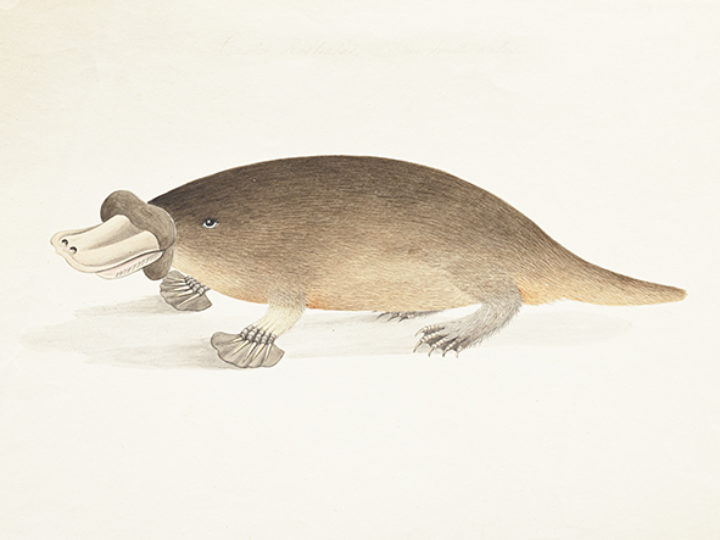Zoology
The Linnean Society was founded in 1788 on the purchased specimen collections (insects, fishes, shells and plants) and library of Carl Linnaeus, but expanded to include the books and manuscripts of the membership at large. Many of these works illustrate animal species from all over the world, and some include type specimens - the specimen or illustration upon which the description of a species is based.

'The Quezal or Golden Trogon', James Wilson, Illustrations of zoology, No. 2, Pl. VI (1831, MS/DAR/270.4:20)
James Wilson (1795–1856) was a Scottish zoologist. His Illustrations of zoology, being representations of new, rare or otherwise remarkable subjects of the animal kingdom was published in nine parts, with four plates of animals drawn from nature in each part. Wilson drew these animals from specimens belonging to the Museum of the University of Edinburgh, with which he was associated. In his description of the quetzal (current name: Pharomachrus pavoninus), Wilson laments at knowing 'little or nothing of the natural history of this beautiful bird', and also writes, 'Of the splendour of this rare and remarkable species, neither description nor delineation can convey any adequate idea'. Wilson's drawing is one-half of the original size and it is presumable that it was based on a specimen sent to the Museum by J. C. Schenley, Esq., who collected possibly the first specimens ever seen in Scotland from Central America. The copy in which this plate is found belonged to Charles Darwin FLS (1809–1882). The Society holds all nine parts that were owned by Darwin, which came unbound with the covers and leaves stab-sewn together with silk ribbon.

'Babouin male', Jean Charles Werner (artist), Étienne Geoffroy Saint-Hilaire & Frédéric Cuvier, Histoire naturelle des mammifères, Vol. 1 (1824, FF 599 GEO)
French naturalists Étienne Geoffroy Saint-Hilaire (1772–1844) and Frédéric (Georges) Cuvier (1769–1832) began their careers as colleagues and friends. In fact, Cuvier took up the role of Assistant Professor of Animal Anatomy at Paris' Muséum d'Histoire Naturelle at the invitation of Geoffroy Saint-Hilaire. However, due to several differing scientific viewpoints, the relationship culminated in a fierce scientific debate in 1830 in front of the French Academy of Sciences. Before the relationship turned bitter, the two did manage to create the beautifully-illustrated 72-part Histoire naturelle des mammifères. Shown here is the plate of a male baboon (genus Papio).

'Ramphastos erythrorhynchus; (Auct:) Red-billed Toucan.', Edward Lear (artist), John Gould, A monograph of the Ramphastidae, or family of toucans (1834, FF 598.72(084.1) GOU)
John Gould FLS (1804–1881) was an English ornithologist and is known for his beautifully illustrated monographs on birds. Gould himself created some of the drawings for his books, but his wife, artist and painter Elizabeth Coxen (1804–1841), and Edward Lear ALS (1812–1888) also drew many of the lithographs for his works. The white-throated, or red-billed, toucan (current name: Ramphastos tucanus) featured in this print was drawn by Lear who is more commonly known today for his nonsensical poetry and prose such as 'The Owl and the Pussy-Cat'. However, Lear was also an accomplished draughtsman, and often drew from live specimens. He is perhaps best known for his very popular Illustrations of the Family of Psittacidae, or parrots (1832).

'[Raccoon]', Laurentius Alstrin, [Linnaean Portfolio] (c.1746, LM/PF/ALS/1)
This pen and ink drawing of a raccoon, 'Ursus lotor' (current name: Procyon lotor), was drawn by Laurentius Alstrin (d. 1775), possibly using Carl Linnaeus's pet raccoon, nicknamed 'Sjupp' ('raccoon' in 18th-century Swedish), as a model. Linnaeus received several animal gifts from the Swedish royal family during his professorship at Uppsala University (he had taken over supervision of the Botanic Garden). On this occasion, around 1746, Crown Prince Adolf Fredrik gave him the raccoon. Linnaeus wrote a paper on Sjupp in which he described the animal's antics; 'should there be any cake or sugar on the table ... he was on it in a flash', and describing his obstinance, 'If anyone led him on a rope and tugged at it, he would immediately lie down and throw his arms and legs about defiantly'. Linnaeus seemed fond of Sjupp, calling him 'our American bear'. Alstrin, who was an apprentice in the Royal Swedish Academy of Sciences, visited Uppsala and Linnaeus in 1746. Sadly, Sjupp died in 1747, having escaped from his enclosure and been attacked by a dog.

'O. Macropus, Risso.', Jean Baptiste Vérany (artist), André Étienne d'Audebard de Férussac & Alcide D'Orbigny, Histoire naturelle générale et particulière des céphalopodes acétabulifères, vivants et fossiles, Pl. 24 (1835-1848, F 594.5 FER)
André Férussac (1786–1836) was a French naturalist who specialised in malacology, or the study of molluscs. He wrote the first 11 parts of Histoire naturelle...des céphalopodes acétabulifères, and French naturalist Alcide d'Orbigny (1802–1857) completed and revised the two-volume work, with Vol. 1 comprising the text and Vol. 2 comprising the plates. The white-spotted octopus (current name: Callistoctopus macropus) in this plate is labelled 'O. Macropus, Risso.', as it was originally described by Antoine Risso (1777–1845). Both Risso and the artist Vérany were from Nice, and Vérany was also a naturalist in his own right who specialised in cephalopods. This species of octopus is found in the shallows of the Caribbean and Mediterranean Seas (though can also be found occasionally in the eastern Atlantic Ocean) and is active mainly at night.

'Trigla volitans. The Flying Fish.', Krüger, Jr (artist), Marcus Elieser Bloch, Ichtyologie, ou, Histoire naturelle, générale et particulière des poissons, Vol. IV, Pl. 351 (1785-1797, F 579 BLO)
Marcus Elieser Bloch FLS (1723–1799) was a German physician and naturalist. He specialised in ichthyology and described 267 new species of fish. His own impressive fish collection was used as a basis for the 12-part Ichtyologie, ou, histoire naturelle...des poissons, which was originally published under its German title, Allgemeine Naturgeschichte der Fische. The work has been described by natural history writer Claus Nissen as 'the finest illustrated work on fishes ever produced'. The flying gurnard (current name: Dactylopterus volitans) depicted in this plate was originally described by Linnaeus in the 10th edition of Systema naturae (1758). This species looks like it is 'flying' over the sandy bottom of the ocean floor, can use its pelvic fins as 'legs' when scouring for food, and can vary in colour intensity when threatened.

'[Platypus]', Thomas Davies, 'Castor Rostratus of New South Wales, or Duck-billed Beaver' (1800, SP/293/2)
This watercolour drawing by British Army Officer and naturalist Thomas Davies FLS (c. 1737–1812) accompanied a paper read at the Society on 4 November 1800, titled 'Castor Rostratus of New South Wales, or Duck billed Beaver'. In the paper Davies writes, 'As I understand, this most extraordinary and singular animall [sic] has already been described by my friend Doctor Shaw, I shall not attempt entering into the Generic Character being perfectly satisfied of his superior abilities in more scientifically performing that matter than myself'. However, Davies wanted to present this drawing to the Society, as he had 'had the satisfaction of seeing three specimens'. The platypus (current name: Ornithorhynchus anatinus) was so bizarre to Europeans, that British scientists first thought it a hoax, and even George Shaw FLS (1751-1813), who first described the animal had his doubts of its authenticity. The Society holds seven papers with accompanying drawings by Davies.
